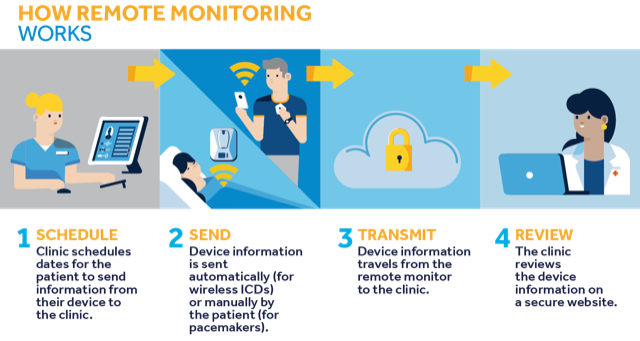What is Home Monitoring
STAYING CONNECTED TO YOUR DOCTOR IS SIMPLE
What is Home Monitoring?
Home monitoring allows Canberra Heart Rhythm, the team of Cardiac Scientists, and Cardiac Nurse at Canberra Heart Rhythm observe your hearts arrhythmias and device function without you needing to come into the clinic. The home monitor provided after your device implant sends transmissions, using the same cellular network that your mobile phone uses, to a secure server that the cardiac scientists review and produce reports for Canberra Heart Rhythm.
They will monitor all alert data that is triggered within your device, whether this be a new or recurring arrhythmia, lead concerns, or device therapy application such as defibrillator shocks, as well as constant monitoring or device function and patient symptoms.
What are the Benefits of Home Monitoring?
Home monitoring facilitates regular viewing of the data collected by your cardiac device and creates direct access to critical information for monitoring heart and device function and provides a direct line of communication between the Cardiac Scientists, Doctors, and patients. This ensures peace of mind for all patients that they are being monitored closely. This can allow for early intervention if there are any changes to your heart or device activity by the team at Canberra Heart Rhythm, and these benefits are being supported through current research, showing that early detection of issues through Home Monitoring leads to improved health outcomes and a reduced number of hospital admissions. Information from your heart device goes straight to your clinic. Your doctor will be alerted if there’s a concern.

CareAlert™ Notifications are available for wireless devices only, and are designated by your clinic.
For more information, please contact our cardiac scientists on 0499 556 095.
- Crossley GH , Boyle A, Vitense H, ChangY, Mead RH; CONNECT Investigators. The CONNECT (Clinical Evaluation of Remote Notification to Reduce Time to Clinical Decision) trial: the value of wireless remote monitoring with automatic clinician alerts. J Am Coll Cardiol. March 8, 2011;57(10):1181-1189.
- Chen J, Wilkoff BL, Choucair W, et al Design of the Pacemaker Remote Follow-up Evaluation and Review (PREFER) trial to assess the clinical value of the remote pacemaker interrogation in the management of pacemaker patients. http://www.trialsjournal.com/content/9/1/18. April 3, 2008.
- Small R, Tang W, Wickemeyer W, et alManaging Heart Failure Patients with Intra-Thoracic Impedance Monitoring: A Multi-Center US Evaluation (OFISSER). J Card Fail. August 2007;13(6); Supp 2;S113-S114
- Landolina M, Perego GB, Lunati M, et al.Remote monitoring reduces healthcare use and improves quality of care in heart failure patients with implantable defibrillators: the evolution of management strategies of heart failure patients with implantable defibrillators (EVOLVO ) study. Circulation. June 19, 2012;125(24):2985-2992.
- Marzegalli M, Lunati M, Landolina M. RemoteMonitoring of CRT-ICD: The Multicenter Italian CareLink Evaluation – Ease of Use, Acceptance, and Organizational Implications. Pacing Clin Electrophysiol. October 2008;31(10): 1259-1264.
- Petersen HH, Larsen MC, Nielsen OW Kensing F, Svendsen JH. Patient satisfaction and suggestions for improvement of remote ICD monitoring. J Interv Card Electrophysiol. September 2012; 34(3):317-324.
- Ricci RP, Vicentini A, D’Onofrio A, et al. Impact of in-clinic follow-up visits in patients with implantable cardioverter defibrillators: demographic and socioeconomic analysis of the TARIFF study population. J Interv Card Electrophysiol. November 2013;38(2):101-106.